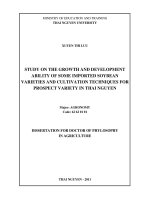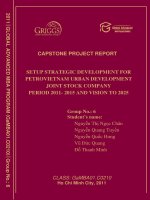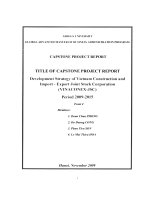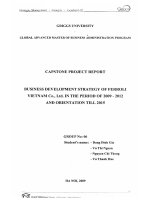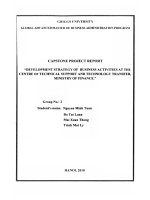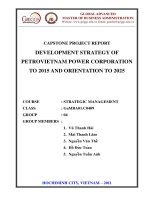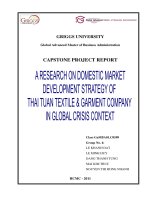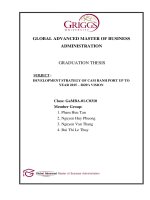Development strategy of petrovietnam powercorporation to 2015 and orientation to 2025
Bạn đang xem bản rút gọn của tài liệu. Xem và tải ngay bản đầy đủ của tài liệu tại đây (1.49 MB, 93 trang )
_____________________________________________________________________________________________
CAPSTONE PROJECT REPORT
DEVELOPMENT STRATEGY OF
PETROVIETNAM POWER CORPORATION
TO 2015 AND ORIENTATION TO 2025
COURSE : STRATEGIC MANAGEMENT
CLASS : GaMBA01.C0409
GROUP : 04
GROUP MEMBERS :
1. V Thanh Hi
2. Mai Thanh Lâm
3. Nguyễ n Văn Thế
4. Hồ Đứ c Toà n
5. Nguyễ n Tuấ n Anh
HOCHIMINH CITY, VIETNAM – 2011
GLOBAL ADVANCED
MASTER OF BUSINESS ADMINISTRATION
Website: www.griggs.edu.vn Email:
1
ACKOWLEDGEMENT
We, Members of Group 4 GaMBA01.C0409, owe a debt of gratitude to many people
who helped us complete this report. We would like to acknowledge the help of all.
Firstly, thank all of leaders of the Global Advanced Program – Master of Business
Administration (GaMBA) have created more favorable conditions for us to participate in
learning and make great graduation exercises. Please thank the management division
classes provided good support and documentation, timely information in the learning
process;
Sincerely thank the teachers who have dedicated instructions and communication of
knowledge, updating the latest information to help us link the knowledge and skills they
have learned to actual work. We always remember the good feelings that most trainers
have for us and the students of class in time;
Thank Board President of PetroVietnam Power Corporation, financial accounting
departments, planning-service, organize administrative, technical safety support to
provide data and comments to complete this graduate seminars.
Finally, to our family, we wish to extend my loving thanks for their encouragement. This
report could not be done without their daily support and encouragement.
Although there has been close cooperation and have tried our best of Group 4, but due to
limited time, so exercises may be large gaps, are looking forward to understanding of the
Teachers and program Leaders GaMBA.
Sincerely,
2
TABLE OF CONTENTS
ACKNOWLEGEMENT…………………………………………………………………1
TABLE OF CONTENTS 2
LIST OF ACRONYMS AND ABBREVIATIONS 6
LIST OF TABLE, DRAWING, CHART 7
INTRODUCTION 9
1. Reasons to choose topics 9
2. Objectives and tasks of research topics 10
2.1. Objectives 10
2.2. Tasks 10
3.1. Research object 10
3.2. Object scope 10
4. Research methods and data sources 11
4.1. Research methods 11
4.2. Data sources 11
5. Contribution benefits of group exercise 11
6. Structural group exercises 11
7. Group memberts 11
CHAPTER 1: THE CONCEPT OUTLINES THEORIES ABOUT STRATEGIC
MANAGEMENT AND THE NEED TO APPLY FOR
PETROVIETNAM POWER CORPORATION 12
1.1. OVERVIEW OF BUSINESS STRATEGY 12
1.1.1. The basic concept of strategy 12
1.1.2. The model of strategic management 13
1.1.3. Some tools for construction and options trading strategy 14
1.1.3.1. External Factors Evaluation Matrix (EFE) 14
1.1.3.2. Internal Factors Evaluation Matrix ( IFE ) 14
1.1.3.3. Construction and selection strategy – SWOT matrix 15
1.2. THE ROLE OF THE PETROLEUM SECTOR IN VIETNAM ELECTRICITY
DEVELOPMENT 16
3
1.2.1. General about Vietnam Electricity Power 16
1.2.2. The role of the petroleum sector in Vietnam electricity development 18
1.2.3. The need of the petroleum sector in Vietnam electricity development … 19
1.3. THE NEED OF STRATEGIC PLANNING OF PETROVIETNAM POWER
CORPORATION 20
CHAPTER 2: BUSINESS DEVELOPMENT STRATEGIC PLANNING OF
PETROVIETNAM POWER CORPORATION 22
2.1. INTRODUCTION ABOUT PETROVIETNAM POWER CORPORATION 22
2.1.1. The formation and development 22
2.1.2. The position and role of PetroVietnam Power Corporation 26
2.1.3. The basic business indicator has achieved in recent years 27
2.1.4. The existence and causes 29
2.2. BUSINESS DEVELOPMENT STRATEGY OF PV POWER CORPORATION TO
2015 AND ORIENTATION TO 2025 30
2.2.1. Business strategies building context 30
2.2.2. Basis for business development strategies building 31
2.2.3. Forecast 2011 - 2015 32
2.2.4. Capacity of PetroVietnam Power Corporation 33
2.2.5. Potential of PetroVietnam Power Corporation - Opportunities and Challenges 34
2.3. PLANNING BUSINESS DEVELOPMENT STRATEGY OF PETROVIETNAM
POWER CORPORATION TO 2015 AND ORIENTATION TO 2025 36
2.3.1. Analysis of the external environment - opportunities and challenges (EFE matrix)36
2.3.1.1. Analysis of general environment 36
2.3.1.2. EFE Matrix 40
2.3.2. Internal Factors Evaluation Matrix –IFE Matrix 41
2.3.2.1. Analysis of internal environment 41
2.3.2.2. IFE Matrix 45
2.3.3. Swot matrix of pv power 46
2.3.4. The strategies formed from swot matrix 48
2.3.4.1. Group of S-O Strategies 48
2.3.4.2. Group of S-T Strategies 48
4
2.3.4.3. Group of W-O Strategies 49
2.3.4.4. Group of W-T strategies 49
2.4. STRATEGIES TO DEVELOP PETROVIETNAM POWER CORPORATION TO
2015 AND ORIENTATION TO 2025 50
2.4.1. Viewpoints 50
2.4.2. Principles 51
2.4.3. Overall targets 51
2.4.4. Specific targets 52
2.4.4.1. In business 52
2.4.4.2. Service business sector 58
2.4.4.3. On investment 59
2.4.4.4. Strategy for training and human resources development 62
2.5. ORIENTATIONS TO THE YEAR 2025 66
2.5.1. Development of power industry 66
2.5.2. Transmission and Distribution 68
2.5.3. Welcoming the beginning stages of the electricity market 68
2.5.4. Other service activities 69
CHAPTER 3: IMPLEMENTING SOLUTIONS FOR STRATEGIES OF PV POWER
CORPORATION 70
3.1. DIFFICULTIES AND PROBLEMS 70
3.1.1. On the production 70
3.1.2. The investment in the development / arranger 71
3.1.2. On the management and human factors: 71
3.2. SOLUTIONS PERFORM STRATEGY 71
3.2.1. Immediate Solution 71
3.2.1.1. Production Solutions 71
3.2.1.2. Capital Investment Solutions: 72
3.2.1.2.1. Investment Solutions 72
3.2.1.2.2. Capital Solutions 72
3.2.1.3. Solutions for Investment Cooperation, International Economic Integration 72
3.2.1.4. Solutions for Organization and Resource Management 73
5
3.2.1.5. Solutions for Training of Science and Technology 73
3.2.1.5.1. Method of training 73
3.2.1.5.2. Solutions for Science and Technology 74
3.2.1.6. Solutions for Environmental Protection 74
3.2.1.7. Solutions for Technical Management and Operations 75
3.2.2. LONG-TERM MEASURES 75
3.2.2.1. Measures for investment and capital 75
3.2.2.1.1. Measures for investment 75
3.2.2.1.2. Measures for capital 76
3.3. RECOMMENDATIONS AND PROPOSALS 78
3.3.1. On the production 78
3.3.2. Investment and Development 78
3.3.3. Capital management 79
3.3.4. Human resource attraction 79
CONCLUSION 80
REFERENCES 81
Appendices 84
6
LIST OF ACRONYMS AND ABBREVIATIONS
PVN
:
Vietnam National Oil and Gas Group (PetroVietnam)
TKV
:
Vietnam National Coal-Mineral Industries Group
EVN
:
Electricity of Vietnam
PV POWER/Corporation
:
PetroVietnam Power Corporation – (PV Power )
LILAMA
:
Vietnam Machinery Erection Corporation
CC1
:
Construction Corporation No.1
Oceanbank
:
Ocean Commercial Joint-Stock Bank
A0
:
National Load Dispatch Centre
A1
:
North Regional Load Dispatch Centre
A2
:
South Regional Load Dispatch Centre
BOT
:
Build – Operate – Transfer
BOO
:
Build – Operate – Own
IPP
:
Independent Power Producer
NPTC
:
National Power Transmission Corporation
EPTC
:
Electric Power Trading Company
O&M
:
Operating costs and maintenance
PPA
:
Power purchase agreements
OEM
:
Original manufacturer
MP 6
:
Master Plan 6: The planning of national electricity
development in 2006-2015 has taken 2025
MP 7
:
Master Plan 7
CDM
:
Clean Development Mechanism
ECA
:
Export Credit
NG
:
Natural Gas
LNG
:
Liquefied Natural Gas
7
LIST OF TABLES
Table 1.1. External Factors Evaluation Matrix - EFE…………………………… 14
Table 1.2: Internal Factors Evaluation Matrix – IFE……………………………….14
Table 1.3: SWOT Matrix 16
Table 2.1: Results of operations for 2008-2010 of PV Power…………………… 28
Table 2.2: Vietnam's major macroeconomic data of period 2005-2009……………37
Table 2.3: External Factors Evaluation Matrix of PV Power (EFE)……………….41
Table 2.4 : Fuel use for factory operation from 2008 to 2010…………………… 43
Table 2.5: The ratio measures the financial ability of PV Power……………………45
Table 2.6: Internal Factors Evaluation MatrixPV Power (IFE)…………………….46
Table 2.7: SWOT Matrix of PV Power …………………………………………….47
Table 2.8: Main targets of PV Power in the period of 2011 -2015………………….52
Table 2.9: Calendar time plants in commercial operation by 2015 ………………….54
Table 2.10: Capital needs in 2011-2015 …………………………………………… 60
Table 2.11: Human resource requirements in 2011-2015……………………………62
Table 2.12: Manpower structure in 2011-2015……………………………………….63
Table 2.13: Cost of postgraduate training period 2010-2025 ……………………… 63
Table 2.14: Costs of operational training, regular training period 2010-2015 …………64
Table 2.15: Total power output of PV Power …………………………………………66
Table 2.16:Gas thermal power output of PV POWER ……………………………… 67
Table 2.17: Coal thermal power output of PV POWER ………………………………67
Table 2.18: Hydropower output of PV POWER …………………………………….68
Table 2.19: Renewable energy power output of PV POWER ……………………… 68
8
LIST OF DRAWING, CHART
Figure 1.1: A model of comprehensive strategic managemen ………………….13
Figure 1.2: The manufacturing process of the electricity industry………………17
Figure 1.3: source structure according to capacity………………………………17
Figure 1.4: source structure according to output ……………………………… 17
Figure 1.5: Source structure according to the owner…………………………….18
Figure 1.6: Structural power consumption 2001-2009………………………… 18
Figure 2.1: Organizational Chart of PetroVietnam Power Corporation…………25
Chart 2.1: Commercial output of PV Power in period from 2011 to 2015………55
Chart 2.2: Revenue PV Power from 2011 to 2015………………………………56
Chart 2.3: The profit from 2011 to 2015…………………………………………57
Chart 2.4: Demand for capital investment in the period from 2011 to 2015…….61
9
INTRODUCTION
1. REASONS TO CHOOSE TOPIC
Energy determines quality of daily life and is one of themost important drives of
economic development. Energy services directly affect the economic efficiency and the
social equity of a country. In Vietnam the development plans of electricity, coal, oil and
gas have been established and revised independently for many years. On the other hand,
average annual energy consumption from 1990 indicated 11% which is 1.5 times of GDP
growth. It is estimated this growth will continue with the average of 8.1% until 2020.
Now, in order to secure energy supply, to maintain sound development for energy sector,
Vietnam needs to consider the development of all sub-sectors based on the unified and
comprehensive strategy.
With the development objectives of Vietnam National Oil and Gas Group
(PetroVietnam – PVN) in the direction of diversification of industry, PetroVienam Power
Corporation (PV Power) was established with the objective to participate in building and
development power supply, power production and business purpose, striving always to
stand in second place (after EVN) in all groups/total production companies - trading
electricity, accounting for about 16% of the national electricity market in 2015, and about
30% in 2020. Therefore, the required to build a "Power development strategy and power
production business of PetroVietnam Power Corporation to 2015 and orientation to
2025", set out specific targets, assess the opportunities and challenges, and outlines
potential areas, the steps along with the implemented solutions, is an objective urgent
requirement. The business strategy of PV Power will be the basis for formulation of
detailed plans for the construction of thermal power and gas, coal, hydro, renewable
energy, including nuclear power, building distribution power networks in the immediate
short-term and involved the construction of transmission power in the long term On
that basis, timely construction of facilities business management, building a team of
technical experts, specialized and synchronized labor to meet the target.
Rational development based on a proper strategy, PV Power definitely will help
build PetroVietnam on a development and contribute more firstly to develop the industry,
then to the industrialization and modernization of the country.
10
Derived from the requirement that we choose the theme "Development Strategy of
PetroVietnam Power Corporation to 2015 and orientation to 2025." for research.
2. OBJECTIVES AND TASKS OF RESEARCH TOPIC
2.1. Objectives:
Systematize the theories and viewpoints on business strategy.
Analyze and assess the actual business activities of PetroVietnam Power
Corporation.
Proposed development strategy to expand business to PetroVietnam Power
Corporation. On the basis of environmental analysis inside and outside to
identify the strengths and weaknesses as well as current threats and
opportunities affecting the development of the corporation.
2.2. Tasks:
In terms of reasoning: the system of some basic theoretical issues, research
common practice issues to clarify the concept of strategic management.
In practice: Analysis of the actual situation of production and business activities
at PetroVietnam Power Corporation, which saw the advantages, disadvantages,
strengths, weaknesses, opportunities and challenges. Since then, we propose
measures to expand production and development PetroVietnam Power
Corporation to 2015 and orientation to 2025.
3. OBJECT AND RESEARCH SCOPE
3.1. Research object:
"Development Strategy of PetroVietnam Power Corporation to 2015 and
orientation to 2025".
3.2. Research scope:
About time: Research the business activities of the PetroVietnam Power
Corporation from 2007-2010.
About space: Research in PetroVietnam Power Corporation.
11
4. RESEARCH METHODS AND DATA SOURCES
4.1. Research methods:
Investigative and statistical analysis;
Comparative analysis;
Systematic analysis.
4.2. Data sources:
Data are taken from the reports of the PetroVietnam Power Corporation; and other
documents of the PetroVietnam, Electricity of Vietnam, Energy Institute, the decrees and
decisions of Government, articles in newspapers, magazines, internet related to the
subject.
5. CONTRIBUTION BENEFITS OF GROUP EXERCISE
The research results will be applied to business strategy of PetroVietnam Power
Corporation in the next period.
At the same time these results can also be used as a reference application for the plant,
the members company of the PetroVietnam Power Corporation.
6. STRUCTURAL GROUP EXERCISES
Besides the introduction, recommendations, conclusions, reference lists and appendices,
exercises structure consists of 3 chapters:
Chapter 1: The concept outlines theories about strategic management and the need
to apply for PetroVietnam Power Corporation.
Chapter 2: Business Development Strategic Planning of PetroVietnam Power
Corporation.
Chapter 3: Solutions and recommendation to PetroVietnam Power Corporation.
7. GROUP MEMBERS
1. V Thanh Hi 3. Nguyễ n Văn Thế 5. Nguyễ n Tuấ n Anh
2. Mai Thanh Lâm 4. Hồ Đứ c Toà n
12
CHAPTER 1:
THE CONCEPT OUTLINES THEORIES ABOUT
STRATEGIC MANAGEMENT AND THE NEED TO APPLY FOR
PETROVIETNAM POWER CORPORATION
1.1. OVERVIEW OF BUSINESS STRATEGY
1.1.1 The Basic Concept Of Strategy:
Business strategy are defined in various ways by managers. This comes from a variety of
approaches to different studies.
According to Fred R. David (2003): Strategy means to achieve long-term goals.
According to Alfred Chandler, the Harvard University: Business strategy, a
determination of the basic objectives and long term business, and how the choice
or course of action and distribution of necessary resources to implement that goal.
According to Rudolf Grunig và Richard Kuhn (2003): a long-term strategy,
direction and management to ensure complete long-term goals, the primary
purposes of the company.
According to Michael E.Porter: Strategy is choice what we need to do and what
not to do, something to meet a group of customers, not all.
According to Mintzberg (1995): summary winth 5 P includes: Plan Pattern,
Position, Perspective, Ploy.
Overall, the concept of business strategy, though there are differences about the wording
but still contained the following contents:
Identify short-term goals and long-term goals for organization.
13
Set and selection solutions to achieve the goal.
Deployment and allocation of resources to implement that goal.
1.1.2 The Model Of Strategic Management:
Strategic management process can be studied and applied through the model. Each
model represents a certain kind of process. Proving performance in Figure 1.1 is a
comprehensive management model (general model) are widely accepted. Model does not
guarantee success, but it represents a clear methodology and practice in the formulation,
implementation and evaluation strategies.
Figure 1.1: A comprehensive strategic management model
(source :Strategic management- PTIT )
Feedback
Measurem
ent and
performan
ce
evaluation
Enforcemen
t Strategy
Formation
Strategy
Assessment
Strategy
Implementing
external controls
to identify
opportunities
Establis
h long-
term
goals
Set annual
goals
Identify
objectives
and tasks of
the current
strategy
Redefin-
ing
business
objectives
Distributi
on of
resources
Implement
internal controls
to identify the
strengths and
weaknesses
Choose
Strategy
to
pursue
Proposed
policies
Feedback
14
1.1.3 Some Tools For Construction and Options Trading Strategy:
1.1.3.1 External Factors Evaluation Matrix (EFE):
This matrix allows summary and evaluation the external environment of business.
Regardless of the main opportunities and threats are included in external factors
evaluation matrix, total score of the highest importance that an organization can have is
4.0 and the lowest is 1, 0. Total score of average importance is 2,5. Total important score
is 4 that organizations are responding very well to the opportunities and threats present in
their environment. The total score of 1 indicates that the strategy that the company did
not set out to take advantage of opportunities or avoiding external threats.
The external factors
Important level
Classification
Important score
List the external factors
Total
Table 1.1. External Factors Evaluation Matrix – EFE
1.1.3.2 Internal Factors Evaluation Matrix ( IFE ):
Internal Factors Evaluation Matrix (IFE) is a tool used to summarize and evaluate
the strengths and weaknesses of the important parts of business function and it also
provides the basis for identifying and evaluating relationships between these
components.
The internal factors
Important level
Classification
Important score
List the internal factors
Total
Table 1.2. Internal Factors Evaluation Matrix –IFE
Excluding the matrix elements within how many factors, total important score can
be classified from the lowest 1.0 to highest 4.0 and the average score is 2.5 Total
important score less than 2.5 for companies that weak internal and higher than 2.5 for the
company showed strong internal.
15
1.1.3.3 Construction and Selection Strategy – SWOT Matrix:
SWOT matrix is an important tool in combination can help managers develop four types
of the following strategies:
Strengths – Opportunities Strategy (SO)
Weaknesses – Opportunities Strategy (WO)
Strengths – Threat Strategy (ST)
Weaknesses – Threat Strategy (WT)
The combination of important elements inside and outside is the most difficult task of
developing a SWOT matrix, it requires a good judge, and will not be a best combination.
SO strategies use the strengths within the enterprise to take advantage of
external opportunities. the organization usually pursue WO strategies, ST or
WT to hold can be in the position where they can apply the SO strategy.
WO strategies improve internal weaknesses by taking advantage of external
opportunities. Sometimes, great external opportunities exist but the enterprise
have internal weaknesses which prevents exploitation of these opportunities.
ST strategies use a strengths to avoid or reduce the impact of external threats.
WT strategies are defensive strategy aimed at reducing internal weaknesses
and avoid external threats.
SWOT matrix chart consists of 9 boxes containing: 4 important elements boxes (S, W, O,
T), 4 strategy boxes (SO, ST, WO, WT), a box is always empty in the top right.
16
Empty Box
O: external opportunities
-
List of opportunities
(3)
T: Threats
-
List of threats
(4)
S: Strong points
-
List of strong points
(1)
SO strategies
-
Use strong points to take
advantage of opportunities
(1+3)
ST strategies
-
Overcome these
uncertainties by utilizing
the strengths
(1+4)
W: weak points
-
List of weak points
(2)
WO strategies
-
Limited primarily to take
advantage of those
opportunities
(2+3)
WT strategies
-
Minimize weaknesses
and avoid threats
(2+4)
Table 1.3: SWOT Matrix
(source :Strategic management- PTIT )
The factors listed to a full, accurate and reflect the strengths and weaknesses, as well as
the risks that companies face in implementing the strategy process. This is an important
basis for strategic choices.
1.2 THE ROLE OF THE PETROLEUM SECTOR IN VIETNAM
ELECTRICITY DEVELOPMENT
1.2.1 General about Vietnam electricity:
Power is one of the main resources to promote economic development and are
indispensable in the daily life of society.
In Vietnam, the electricity industry is one of the key sectors and get the attention of the
State. Vietnam is a developing country so demand for electricity is increasing, most
power plant is operating at full capacity now, but power shortages for living and
production continues. Producing electrical output of the whole country for 9 months in
2010 (according to EVN) - commercial electricity demand was 63.2 billion kWh, up
14.8% over the same period and more than 2 times higher than GDP growth. By the end
of 2010, electricity production and purchase of EVN is 72.031 billion kWh, including
17
electricity production was 44.0 billion kWh, electricity is bought 28.03 billion kWh
(purchased from China 4.06 million kWh).
Vietnam's power sector is considered monopolistic industries with high position of
Electricity of Vietnam (EVN). EVN has important role in the production stage,
transmission and distribution.
Currently a series of power plants, electricity transmission networks and
distribution of advanced and modern are being built, with the participation of investment
of foreign investors (BOT Phu My 2 power company and Phu My 3) or investors in
countries such as PetroVietnam (PVN), Coal and Mineral Group of Vietnam (TKV),
General Vietnam Machinery Installation Corporation (Lilama)
Production process of the electricity industry:
Figure 1.2: Production process of the electricity industry - (Source EVN)
Restructuring the electricity industry: (Source EVN)
Figure 1.3: Figure 1.4:
source structure according to capacity source structure according to output
- (Source EVN) - (Source EVN)
18
Source structure according to the owner: (Source EVN)
Figure 1.5 Source structure according to the owner- (Source EVN)
Structural power consumption 2001-2009 (Source: Energy Institute)
Figure 1.6 Structural power consumption 2001-2009- (Source Energy Institute)
1.2.2 The Role Of The Petroleum Sector In Vietnam Electricity Development:
Currently, the structure of the electricity industry is being held in the model of
vertical integration, including power generation, transmission, distribution, purchasing
power and operating system. This does not create transparent environment for attracting
investment in new power sources.
Although no longer exclusive power, EVN has the dominant portion of total
generation capacity (about 65%), and hold the rest of the stages of transmission,
distribution. To address the lack of capital, power works behind schedule, leading to
power shortages, power cuts of constant rotation. Therefore it was time to restructure the
power sector should soon be studied seriously and implemented soon.
In recent years the electricity industry has seen strong growth contributes to our
economic growth. In particular, an important contribution to the achievement, Vietnam
19
Oil and Gas Corporation former and PetroVietnam (PVN) now is played an important
role in supplying gas for about 4,500 megawatts (representing over one third of total
national power generating capacity) gas fired power plants in the South. In the next
period, Vietnam's economy is forecast to continue rapid growth and stability. Therefore,
the power supply stability and reliability to ensure sufficient energy for development
needs become more urgent and necessary.
1.2.3 The Need Of The Petroleum Sector In Vietnam Electricity Development:
To implement the policy of developing the State's power industry of Vietnam are
specified by the mentioned electricity development plan, has prompted many industries
to invest power development to diversify investment strengthen the competitiveness and
efficiency of electricity production.
PVN is constructing nearly 2,000 MW in Nhon Trach and Ca Mau, and is
preparing to continue investment in thermal power and hydropower. By the end of 2010,
electricity production of PVN accounts for 10% in capacity and 15% in output about of
national electricity production, it will contribute to overcoming the critical shortage of
power, ensuring growth of the national economy in the ahead years.
Policy to diversify investment in building power supplies, a growing number of
branches and units outside EVN join to construct power company. By 2010, the power
structure has changed significantly. With investment participation increasing by many
other components, from almost the entire ownership of power plants, now EVN owns
and holds stakes in about 65% of the total power capacity.
Before, many people think the petroleum industry is simply the exploitation of
natural resources industry, specializing in smoking oil sent for export, but it has become
extremely outdated nowadays. The petroleum industry is shouldering an enormous
mission. Not only is the backbone, as the leader of the economy, a model for state
enterprises to follow, the petroleum industry is also assuming the role of macro-
regulation instruments of the Government, efforts to ensure the program of energy
security, food security and social security in the whole country.
Besides mining tasks, oil exports, oil and gas industry is now trying to do the
conversion efficiency, resource exploitation and processing of petroleum products was
20
into gas, into electricity, into fertilizer to serve the country's economy, contributing to
improving people's lives
In the context of lack of electricity for social economic development in 2011 and
future years, the role of a leading economic group, PetroVietnam is focusing all
resources, investment in downstream, including the key projects of urgent national power
is a major effort. The role of the oil industry in the development of electricity in Vietnam
is not only significant contribution of infrastructure on economic importance of energy
for the country, overcoming the power shortage, but also contribute directly to
development - economic development of local society, promote industrial production in
the area, creating an economic restructuring toward industrialization, create large
revenues to the budget. Along with the investment projects producing power of large
scale has been developed, forming a large power center in the region in the country,
PetroVietnam and PetroVietnam Power Corporation are implementing effective
programs of national energy security.
1.3 THE NEED OF STRATEGIC PLANNING OF PETROVIETNAM
POWER CORPORATION
With the development objectives of PetroVietnam (PVN) in the direction of
diversification of industry, PV Power under PetroVietnam was established with the
objective to participate in building and development power supply, power production and
business purpose, striving always to stand in second place (after EVN) in all groups/total
production companies - trading electricity, accounting for about 16% of the national
electricity market in 2015, and about 30% in 2020. Therefore, we required to build a
"Power development strategy and power production business of PetroVietnam Power
Corporation to 2015 and orientation to 2025", set out specific targets, assess the
opportunities and challenges, and outlines potential areas, the steps along with the
implemented solutions, is an objective urgent requirement. Business strategy of
PetroVietnam Power Corporation will be the basis for formulation of detailed plans for
the construction of thermal power and gas, coal, hydro, renewable energy, including
nuclear power, building distribution power networks in the immediate short-term and
21
involved the construction of transmission power in the long term On that basis, timely
construction of facilities business management, building a team of technical experts,
specialized and synchronized labor to meet the target.
Rational development based on a proper strategy, although PetroVietnam Power
Corporation is a newly formed corporation, but PV Power will definitely help build
PetroVietnam on a development and contribute more firstly to develop the industry, then
to the industrialization and modernization of the country.
22
CHAPTER 2:
BUSINESS DEVELOPMENT STRATEGIC PLANNING OF
PETROVIETNAM POWER CORPORATION
2.1. INTRODUCTION ABOUT PETROVIETNAM POWER CORP.
2.1.1. The Formation and Development:
With the permission of the Prime Minister at Document No.2259/TTg-DMDN
02/05/2007 approves the project on establishment of the PetroVietnam Power
Corporation, dated 17/05/2007, the Board of PetroVietnam (PVN) has decided on the
establishment of 1468/QD-DKVN PetroVietnam Power Corporation (PV Power) with
the charter capital of 7,600 billion VND.
PetroVietnam Power Corporation (PV Power) was founded with the goal of
participating in construction and power development, power production, striving to
account for 25-30% of national electricity markets 2025. PV Power was born in the early
stages when the PVN is implementing the development strategy of the petroleum
industry in Vietnam until 2015 and orientation until 2025, and a phase transfer PVN
changing patterns of activity from the Corporation model to economic group model. In
the strategic developing direction, PVN has the potential to promote his new field of oil
and gas industry: production and electricity trade, based on the advantage of abundant
natural gas resources are exploited.
PetroVietnam Power Corporation is a unit member's 100% owned PetroVietnam,
organized by business type Limited Company, is assigned to manage and operate
projects investment in manufacturing and trading, continuing to invest in power projects
at home and abroad.
Transaction name in English: PETROVIETNAM POWER CORPORATION
Abbreviation in English: PV POWER
Head Office: Floors 8, 9 Petroleum Institute Building , Trung Kính, Yên Hòa, Cầu
Giấy, Hà Nội City.
23
By the end of 2010, the charter capital is 10,738,000,000,000 VND
Functions and duties of PetroVietnam Power Corporation:
Development of power industry.
Provide electrical engineering services: Monitoring operation, maintenance,
training, operation, operation of power plants BOO, IPP, BOT
Provide power consulting services: design consultancy, supervision consultants,
technology transfer, consulting investment
Manufacture and sales of electrical equipment: Serving the industrial, civil, power
plants, transmission systems and distribution.
The sector of trade, investment and join the real estate business: This is the area of
support for business activities of corporations, regulated the development of
market demand.
The unit members of PetroVietnam Power Corporation include:
Units:
Branch PetroVietnam Power Corp. – PV Power Cà Mau.
Branch PetroVietnam Power Corp. – PV Power Nhơn Trạch.
Thi Bnh 2 Project Management Board.
1 subsidiary company has 100% the charter capital of PV Power:
PetroVietnam Power Renewable Energy Limited Company (Capital 150 billion VND).
Business lines:
Investment, development, construction, ownership, operation and exploitation
of clean energy projects, renewable energy (wind power, geothermal, biomass );
Manufacture and sale of electricity;
Provide services for maintenance and repair of wind power stations.
7 Joint stock companies held by the PV Power the right to govern:
24
PV Power Consulting joint stock company – PVPE (corporations contributed 10.2
billion VND equivalent to 51% of charter capital).
PV Power Services joint stock company – PVPS (corporations contributed 76.5
billion VND equivalent to 51% of charter capital).
PV Power Nhon Trach 2 joint stock company (corporations contributed 1.326,
billion VND equivalent to 51,8% of charter capital).
Dakdrinh Hydro Power DHC PV Power joint stock company (Corporation
contributed 703.08 billion VND equivalent to 75.6% of charter capital).
Hua Na Hydropower HHC PV Power joint stock company (Corporation
contributed 997.884 billion VND equivalent to 55.438% of charter capital).
PetroVietnam Power Backan joint stock company (Corporation contributed
56.772 billion VND equivalent to 66.61% of charter capital).
PV Power PCC Consulting Project joint stock company (corporations contributed
19.6 billion VND equivalent to 49% of charter capital).
14 Affiliates
Sông Và ng hydropower joint stock company (corporations contributed 47,2867
billion VND equivalent to 33,068% of charter capital).
Bat Đai Sơn hydropower joint stock company (corporations contributed 4,79288
billion VND equivalent to 11% of charter capital).
Northwest Viwaseen hydropower joint stock company (corporations contributed
15 billion VND equivalent to 10% of charter capital).
The Northwest Investment and Power Development joint stock company
(corporations contributed 26,8 billion VND equivalent to 8,93% of charter
capital).
Hong river Energy joint stock company (corporations contributed 30,695 billion
VND equivalent to 43,85% of charter capital).
Nam Chien hydropower joint stock company (corporations contributed 292,
billion VND equivalent to 35% of charter capital).
